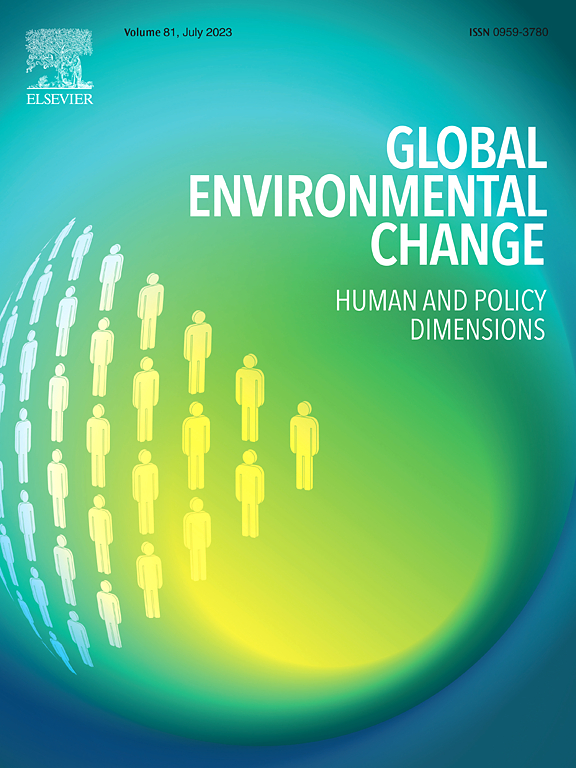Trade agreements and environmental provisions: a counterfactual analysis of environmental impact shifting under global economic inequality
IF 9.1
1区 环境科学与生态学
Q1 ENVIRONMENTAL SCIENCES
引用次数: 0
Abstract
Regional trade agreements (RTAs) have proliferated in recent decades, with increasingly stringent environmental clauses aimed at mitigating trade impacts. However, studies on the environmental effects of RTAs typically focus on a few agreements and indicators, hindering a comprehensive understanding of their effects across various resources. Additionally, the long-term effectiveness of environmental provisions within RTAs remains unclear. To address this gap, we applied a rigorous counterfactual analysis to evaluate changes in multiple resource footprints associated with RTAs and environmental provisions across 195 countries annually from 1990 to 2018. We examined four key resources: primary energy, raw materials, blue water, and land use. Findings revealed that RTAs were linked to the outsourcing of environmental footprints across all resource types while reducing footprint insourcing, a phenomenon known as environmental impact shifting. This effect was particularly evident in wealthier countries, where outsourcing of primary energy, primarily from lower-income nations, rose by 11.6%, raw materials by 13.6%, and land use by 33.5%, compared to similar non-RTA countries. Furthermore, these countries’ insourcing of primary energy was reduced by 48.3% and blue water by 15.4% relative to non-RTA counterparts. Environmental provisions within RTAs had limited long-term effectiveness in reducing environmental footprints outsourcing. Global trends show a growing disparity in resource use between wealthy and poor countries, exacerbated by RTAs. Rigorous footprint accounting and a resource-equity mechanism, including ecological premiums for resource-intensive imports, are essential within RTAs. Wealthier nations must adopt more accountable consumption-based governance, prioritising reductions in material consumption to alleviate the socio-ecological impacts on poorer countries.
贸易协定与环境条款:全球经济不平等下环境影响转移的反事实分析
近几十年来,区域贸易协定(rta)激增,旨在减轻贸易影响的环境条款越来越严格。然而,关于区域贸易协定环境影响的研究通常集中在少数协定和指标上,阻碍了对其在各种资源上的影响的全面了解。此外,区域贸易协定内环境条款的长期有效性仍不清楚。为了解决这一差距,我们采用了严格的反事实分析,评估了1990年至2018年间195个国家与区域贸易协定和环境规定相关的多种资源足迹的年度变化。我们考察了四种关键资源:一次能源、原材料、蓝水和土地利用。研究结果显示,区域贸易协定与所有资源类型的环境足迹外包有关,同时减少了足迹内包,这一现象被称为环境影响转移。这种影响在富裕国家尤为明显,与类似的非区域贸易协定国家相比,这些国家的初级能源外包(主要来自低收入国家)增长了11.6%,原材料外包增长了13.6%,土地使用外包增长了33.5%。此外,与非区域贸易协定国家相比,这些国家的一次能源内包减少了48.3%,蓝水内包减少了15.4%。区域贸易协定内的环境规定在减少环境足迹外包方面的长期效力有限。全球趋势显示富国和穷国在资源利用方面的差距越来越大,区域贸易协定加剧了这种差距。严格的足迹核算和资源公平机制,包括资源密集型进口的生态溢价,在区域贸易协定中是必不可少的。富裕国家必须采取更负责任的以消费为基础的治理,优先减少物质消费,以减轻对贫穷国家的社会生态影响。
本文章由计算机程序翻译,如有差异,请以英文原文为准。
求助全文
约1分钟内获得全文
求助全文
来源期刊

Global Environmental Change
环境科学-环境科学
CiteScore
18.20
自引率
2.20%
发文量
146
审稿时长
12 months
期刊介绍:
Global Environmental Change is a prestigious international journal that publishes articles of high quality, both theoretically and empirically rigorous. The journal aims to contribute to the understanding of global environmental change from the perspectives of human and policy dimensions. Specifically, it considers global environmental change as the result of processes occurring at the local level, but with wide-ranging impacts on various spatial, temporal, and socio-political scales.
In terms of content, the journal seeks articles with a strong social science component. This includes research that examines the societal drivers and consequences of environmental change, as well as social and policy processes that aim to address these challenges. While the journal covers a broad range of topics, including biodiversity and ecosystem services, climate, coasts, food systems, land use and land cover, oceans, urban areas, and water resources, it also welcomes contributions that investigate the drivers, consequences, and management of other areas affected by environmental change.
Overall, Global Environmental Change encourages research that deepens our understanding of the complex interactions between human activities and the environment, with the goal of informing policy and decision-making.
 求助内容:
求助内容: 应助结果提醒方式:
应助结果提醒方式:


